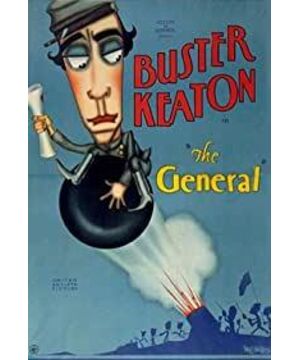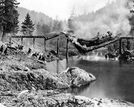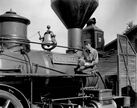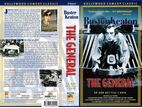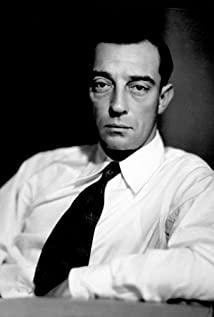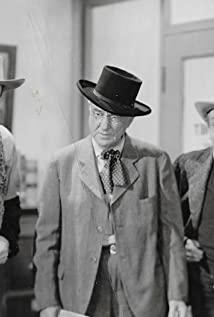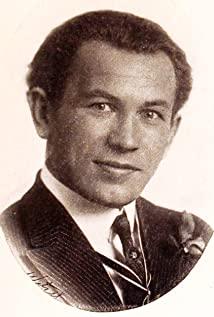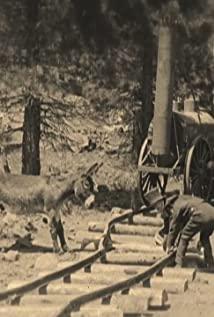The chase scene wasn't a first for Buster Keaton, but he brought it to its peak during the silent era. I'm talking about The General (1926), which he wrote, directed, acted, and edited .
Although it is a long time ago, it is still a silent film, but today, "The General" is not unconventional. In a way, it shares the timeless charm and timeless value of Chaplin's comedies.
Keaton's films are always inseparable from the two elements of chase and love . He always clumsily courted his lover at the beginning of the film, discouraged by a string of failures. But when he woke up the next day, he became a whole new person, and he continued to achieve success, and finally he was a beautiful woman.
The researchers pointed out that Keaton's plot design conforms to Freitag's inverted V structure and Field's three-part act . Almost all of Keaton's feature-length comedies use this basic form of comedy.
In this film, Keaton is the driver of the "General" train. There are two favorite things in his life, his girlfriend (a little girl who looks vain and squeamish now), and his train.
The historical background is that during the American Civil War, Keaton planned to enlist in the army in order to please his girlfriend, but was rejected by the authorities on the grounds that he was more valuable to the war as a train driver. But his girlfriend mistook Keaton for a coward. "Don't try to talk to me until you're in your military uniform."
The above episode is the first part ( the first quarter ), the second part starts with a whole year omitted from the story, and the rest takes place within 24 hours. The first paragraph of the second part is that the girlfriend boarded the "General" to visit her wounded father, the train was hijacked halfway, but the girlfriend left on the train by mistake. The rest of the time is a full chase scene, with Keaton chasing the General ( second quarter ) heading north, interspersed with gags, each containing a prop: a telegraph wire , switch tracks, water towers, cannons, and more, Keaton is at the center of these jokes.
Another chase ( third quarter ) started the next day, in contrast to the previous day, the joke fell on the Yankees, and the sections were reversed, mostly similar to the first chase: Telegraph Electric wires, logs on rails, water towers and burning bridges, etc. The plot is similar, but the fun is different.
The third part is the battle scene between the North and South armies ( fourth quarter ). Keaton made some more jokes. In the end, the Confederates won. His heroic deeds earned him the title of officer and the love of his girlfriend.
As I tell it this way, it seems like the plot is rather rigid and formulaic. In fact, as those French admirers have pointed out, Keaton's rigor in structural design rivals that of the great Neoclassical artists of the 18th century. The latter designs parallel lines or faces to be very complex, but with clever balance and symmetry.
And, the ostensibly formalized plot structure, through Keaton's realism—playing in those dangerous action sequences, absolutely historical costume sets, and even train designs—is charming and passionate.
Classicism is a mixture of two extreme styles, realism and formalism, to form an intermediate style. From this point of view, Keaton's combination of realism and formalistic narrative is typical of classic cinema .
The social critique of Buster Keaton's films may not be as profound as Chaplin's, but it is more in line with the aesthetics of the screen . Instead of garnering sympathy with his tragic stories, he provokes the audience's nerves purely with movement. He leads the audience's gaze in front of the camera, grabbing everything around him in action. And he is always calm and expressionless, waiting for the audience to project their own fears and hopes. This ordinary little person keeps proclaiming the simplest truth to us: no matter how difficult the encounter is, we should find the right direction, seize the opportunity to jump, and cross the past with wisdom and courage.
That's why the little conductor in The General fascinates us. The train rushes through the countryside and fields. The mountains, lakes, and plains of nature set off Keaton's insignificance, and highlights the wisdom and strength he contains.
Keaton never used a studio, but shot everything on location. All the action scenes are hands-on, usually successful one or two times.
The film switches between long-range and close-range scenes. Even in the long-range chase scene, the intense and dense action and rhythm are not weakened, which always makes people feel emotional. The scene of blowing up the bridge became the action climax of the whole film. The crew really blew up a bridge, causing the locomotive to fall into the surging river water wrapped in flames and scalding steam.
Completely real shooting makes this scene the most expensive single shot in silent film history , costing $42,000 (more than half a million today). At three in the afternoon, Keaton motioned for six photographers to start shooting. The unmanned locomotive drove onto the track, and the skids on the bridge had been partially sawed off. When the fire line ignited the explosives, the whole bridge was broken in half, and the locomotive fell with it. A dummy was placed in the front control room to create the illusion that the locomotive had been killed in the line of duty. More than one woman in the onlookers is said to have fainted as the mangled dummy heads floated down with steam. The frightened expressions of the Federal Army in the film are completely fake, because the crew did not inform the actors in advance of the upcoming train disaster. For the next 15 years, the locomotive lay quietly on the riverbed. It was not until World War II that it was salvaged, sold as scrap iron, and made into weapons.
"The General" became the most expensive film in Keaton's life. The audience's response was mediocre, and the critics were not optimistic. The film was not rediscovered until many years later and entered the halls of great cinema.
Public number: movie box (laodianyinghualang)
View more about The General reviews


